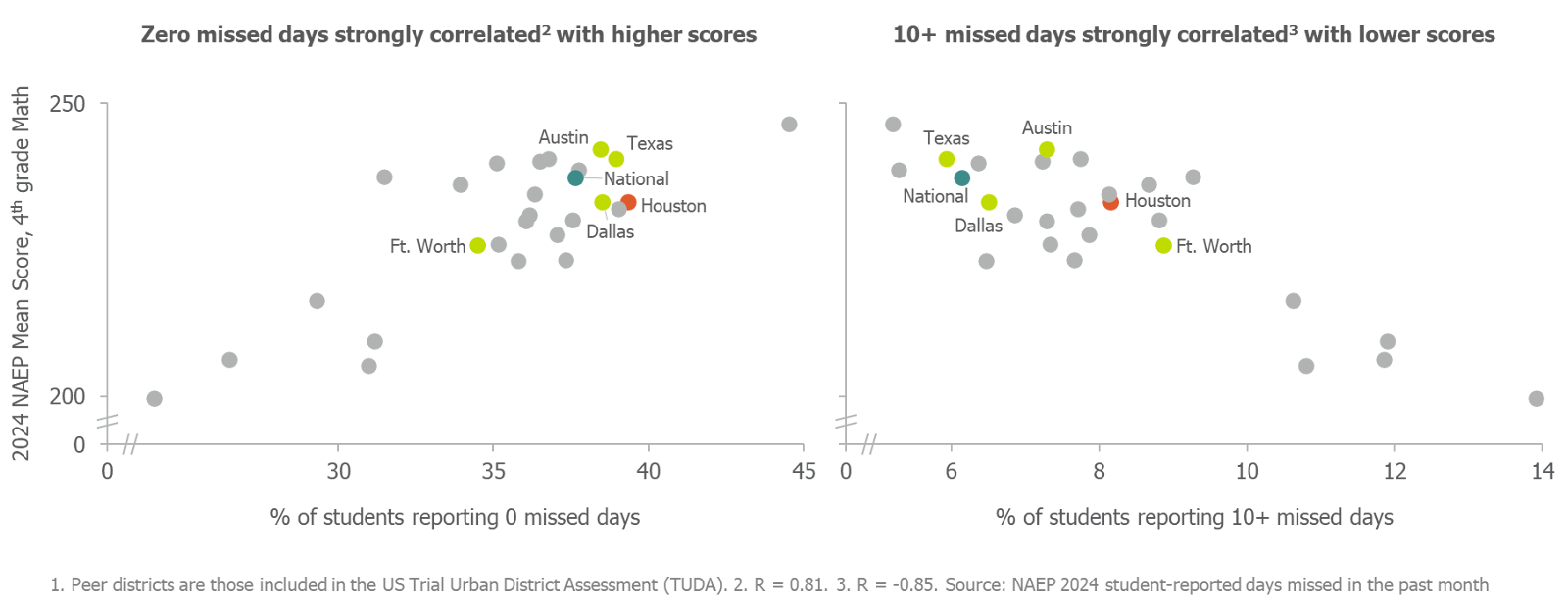When students attend school, it improves their long-term outcomes. Recently, the Houston Education Research Consortium (HERC) found that students who attended pre-kindergarden were less likely to be chronically absent in early elementary school and National Center for Education Statistics (NCES) research found that low attendance is a key predictor of academic challenges and high school dropout.


Here, we consider outcomes for students and highlight a few districts that are working on reducing chronic absenteeism.
Student achievement and chronic absenteeism are related
The National Assessment of Educational Progress (NAEP) serves as the “Nation’s Report Card.” It is administered by NCES, which is housed in the US Department of Education, and administered to 4th and 8th graders every two years in select school districts across the country. Houston ISD participates.
Across districts and grade levels, chronic absenteeism has a negative impact on NAEP reading and math scores. Focusing on math, in districts with a higher percentage of students reporting five or more missed days, the lower their average math scores. The strongest impact is on 4th graders, who are learning foundational math skills necessary to succeed in upper level math courses. Compared to other large urban districts, HISD had a greater percentage of students reporting zero missed days in the month preceding the NAEP test and had average 4th grade math scores in line with peer districts across the country. On the other hand, HISD had a greater percentage of 4th graders reporting more than 10 days absent in the month preceding the NAEP test and had lower average math scores compared to districts with less absenteeism. This evidence points to the need for districts to address chronic absenteeism directly, as opposed to just leaving it up to schools.
Houston region districts mixed on bringing down chronic absenteeism
Progress on addressing chronic absenteeism across the Houston region is mixed. Regionally, the number of chronically absent students declined by 25,000 students from 2022-23 (174,304 in 2021-22 compared to 148,496 students in 2022-23). Every Houston region school district saw a decline in overall chronic absenteeism rates. Most notably, Texas College Prep Academies saw a 9-% point decline, along with Idea Public Schools, Klein ISD, and Spring ISD, who experienced a 7-% point decline in chronic absenteeism, respectively.

Local charter school networks also saw declines in their chronic absenteeism rates, dropping 5-% points from 2022 to 2023, a slightly bigger decline than independent school districts. This suggests that districts and charters might learn from each other as each strategizes to reduce chronic absenteeism in the service of student learning.
From our work across the Houston region, we know that districts are pursuing several strategies to promote school attendance. These include strengthening parent communication and relationships, and incentivizing school-going behavior through activities and celebrations, including awards for students and campuses. Campus-level tactics are prevalent, with some attempting to address absenteeism through restorative practices right when the problem starts. Campuses have also turned to contracts that include clear roles and responsibilities for student and parent, including attendance.

Learning from other districts
For our efforts to improve instructional materials, tools, and practices to matter, students must be in school. Our work with Boston Consulting Group examining NAEP scores across the country points to several strategies Houston region districts and charter networks might pursue to improve chronic absenteeism. Los Angeles Unified School District (LAUSD) and DC Public Schools (DCPS) are two districts that took steps after the pandemic to improve chronic absenteeism. LAUSD collectively focused on improving accountability by keeping an attendance tracker posted on the website. DCPS took a three-pronged approach, focusing on 1) making school joyful and fun; 2) engaging families; and 3) addressing needs of students and barriers to attendance. These efforts align with best practices recommended by researchers, such as engaging the community in reducing chronic absenteeism through public information campaigns, extracurricular activities, and alleviating public transportation problems.
What is clear is that addressing chronic absenteeism is one important step in improving student learning outcomes. To achieve our goals, districts must think creatively about how they engage schools, communities, and policymakers in their efforts.




